A pull workout is a strength training routine targeting all the muscles involved in pulling things off the floor or toward your torso.
You train these muscles by doing “pull exercises.”
Typically, pull workout exercises are variations of deadlifts, rows, pull-ups, and pulldowns, though pull day routines often also include biceps and forearms exercises.
In this article, you’ll learn exactly what a pull workout routine is, which muscles you train in a pull day workout, why pull workouts are beneficial, the best pull exercises to include in your workouts, an example pull workout plan, and more.
What Is a Pull Workout Routine?
A pull day routine is a type of workout in which you train all the muscles involved in pulling things off the floor or toward your torso.
Pull workout plans are typically part of “push pull legs split,” which is a method of organizing your training that dedicates specific days to exercises that focus on either pushing, pulling, or training your lower body.
Muscles Worked in a Pull Workout Routine
Pull day exercises train your . . .
Here’s how these muscles look on your body :

The Benefits of Pull Day Workout Routines
1. They help you avoid muscle imbalances.
Many weightlifters focus on training the muscles you can see in the mirror but neglect the muscles on the back of their body.
Over time, this can cause size and strength imbalances, which spoil your “aesthetics,” and may increase your risk of injury.
A well-structured pull day routine prevents this by ensuring you regularly train your pulling muscles, so they never lag too far behind your “pushing” muscles.
2. They improve your performance on other key exercises.
A strong back is essential if you want to lift heavy weights—it prevents you from tipping forward in the squat, stops your spine from rounding in the deadlift, and creates a stable base during the bench press.
Following a good pull day workout routine helps you strengthen your back and, thus, boosts your performance on other key exercises.
3. They’re time-efficient.
While training splits that involve training a single muscle group per session can work, they aren’t the most time-smart way to train.
Doing 1-to-2 upper body pull workouts weekly is much more efficient because they allow you to train all of your back muscles and your biceps in a single session.
The Best Pull Workout Exercises
Here are the 10 best pull exercises to include in your pull workout plan.
1. Deadlift
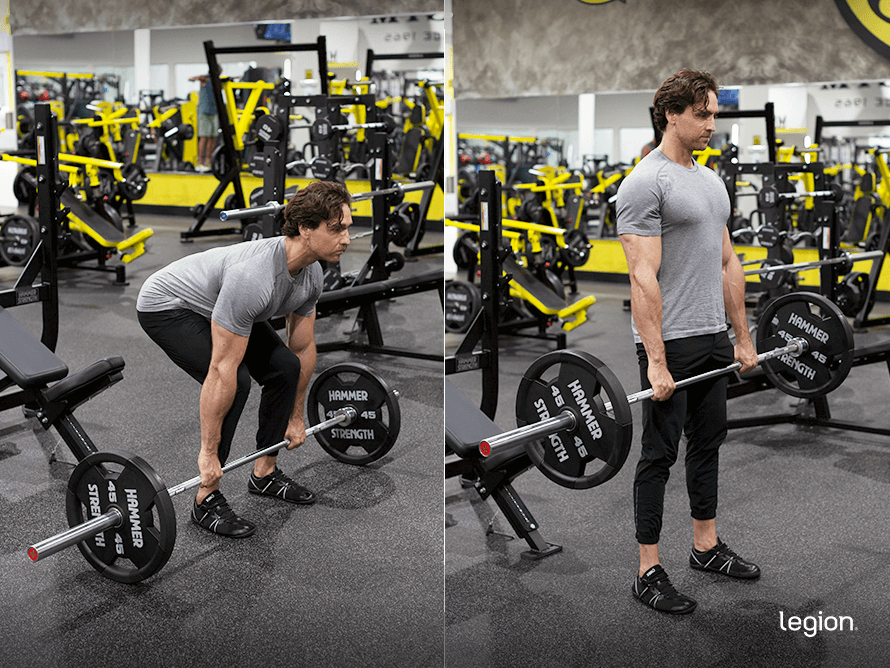
The deadlift is the best all-around pull day exercise because it trains every muscle on the back of your body, allows you to lift heavy weights safely, and progress regularly, making it ideal for gaining size and strength.
How To:
- Position your feet slightly narrower than shoulder-width apart with your toes pointed slightly out.
- Move a loaded barbell over your midfoot so it’s about an inch from your shins.
- Take a deep breath into your belly, then grab the bar with an overhand grip (palms facing you) just outside your shins.
- Flatten your back and drive your body upward and slightly back by pushing through your heels until you’re standing upright.
- Reverse the movement and return to the starting position.
2. Pull-up

How to:
- Grab a pull-up bar slightly wider than shoulder-width apart with your palms facing away from you.
- Lift your feet so that you’re hanging with your arms straight.
- Pull your body up until your chin is above the bar.
- Once your chin has passed the bar, lower yourself under control to the starting position in a reverse motion.
3. Chin-up

How to:
- Grab a pull-up bar with your hands around shoulder-width apart and your palms facing toward you.
- Lift your feet so that you’re hanging with your arms straight.
- Pull your body up until your chin is above the bar.
- Once your chin has passed the bar, lower yourself under control to the starting position.
4. Barbell Row
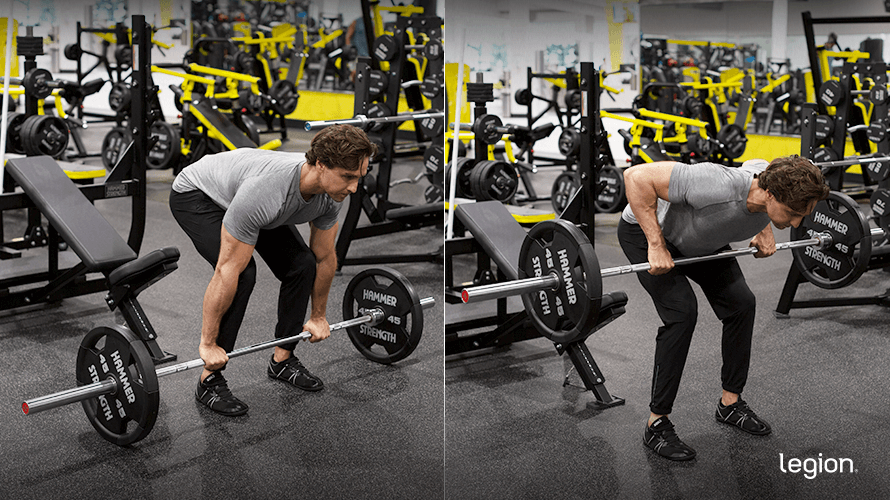
How to:
- Position your feet shoulder-width apart under a loaded barbell with your toes pointed slightly outward.
- Bend over and grab the bar with a slightly wider than shoulder-width grip and with your palms facing toward you.
- Straighten your back and raise your hips until your back is roughly parallel to the floor.
- Driving through your legs, then, using the momentum generated by your lower body, squeeze your shoulder blades together and pull the barbell to your upper body, touching it anywhere between your lower chest and belly button.
- Reverse the movement and return it to the starting position.
5. One-Arm Dumbbell Row
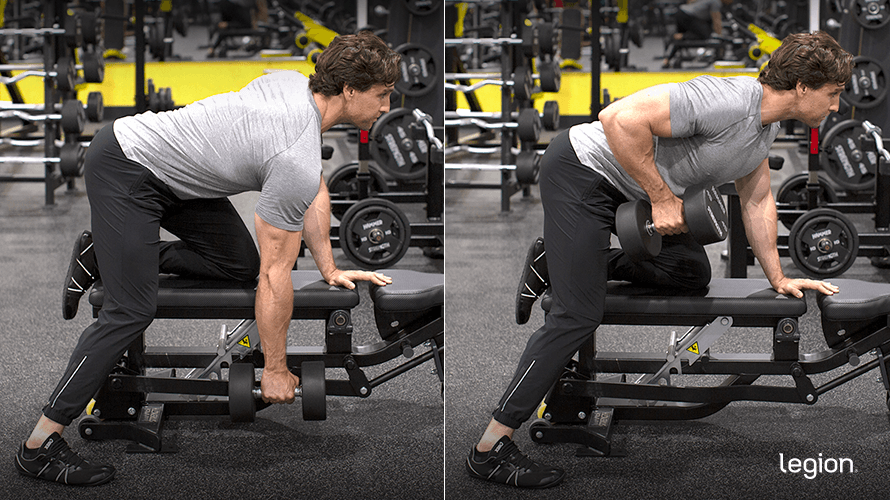
How to:
- Hold a dumbbell in your right hand.
- Plant your left knee and arm firmly on a bench, your right foot on the floor a foot or two from the bench, and let your right arm hang straight down toward the floor).
- Keeping your back straight, pull the dumbbell upward until it touches your torso, and then return it to the starting position.
- Once you’ve completed the desired number of reps, repeat the process with your left arm.
6. Lat Pulldown
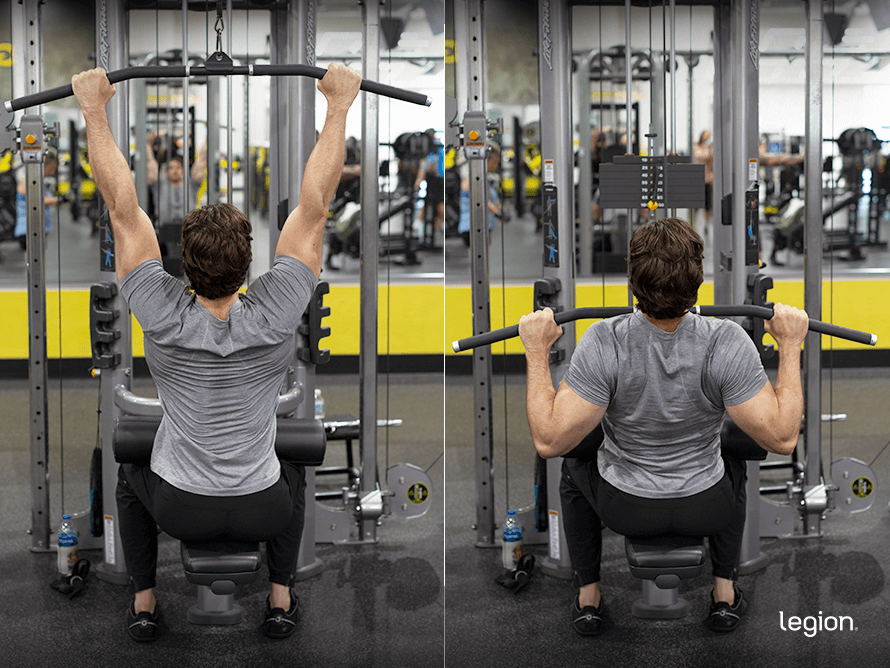
How to:
- Adjust the thigh pad so that it locks your lower body in place.
- Stand up and grab the bar. While keeping your grip on the bar and your arms straight, sit down, allowing your body weight to pull the bar down with you.
- Nudge your thighs under the pads and plant your feet on the floor.
- Pull the bar toward your chest.
- Once the bar is underneath your chin, reverse the movement and return to the starting
7. Cable Row
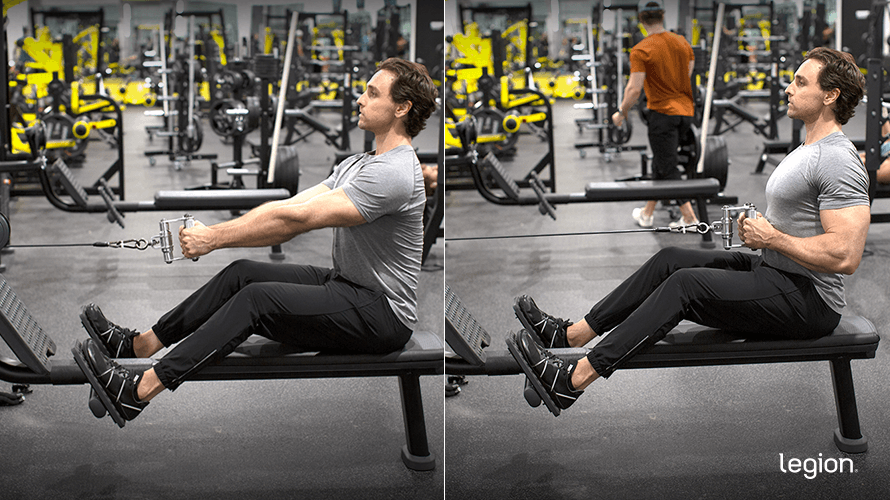
The cable row provides consistent tension on the back and biceps throughout the entire movement, taxing your muscles slightly differently than free-weight pull day exercises.
How to:
- Sit down and place your feet on the foot-rest while maintaining slightly bent knees.
- Lean forward and grab the handle, then lean back with your arms stretched in front of you.
- Straighten your back and pull the cable toward your stomach.
- Once your hands touch your torso, reverse the movement and return to the starting position.
8. Cable Pullover

The cable pullover trains your lats in a fully stretched position and through a long range of motion, which is generally superior for muscle growth.
How to:
- Set the pulley to the highest position on a cable machine and attach the rope handle.
- Hold one end of the rope in each hand, and step away from the pulley until there’s tension in the cable.
- Position your feet shoulder-width apart, and lean forward until your body makes a 45-degree angle with the floor and your arms are nearly straight overhead.
- Keep a small bend in your elbows and pull the rope in an arc toward your feet until your hands are by your thighs or a little past them.
- Reverse the movement and return to the starting position.
9. Dumbbell Rear Lateral Raise
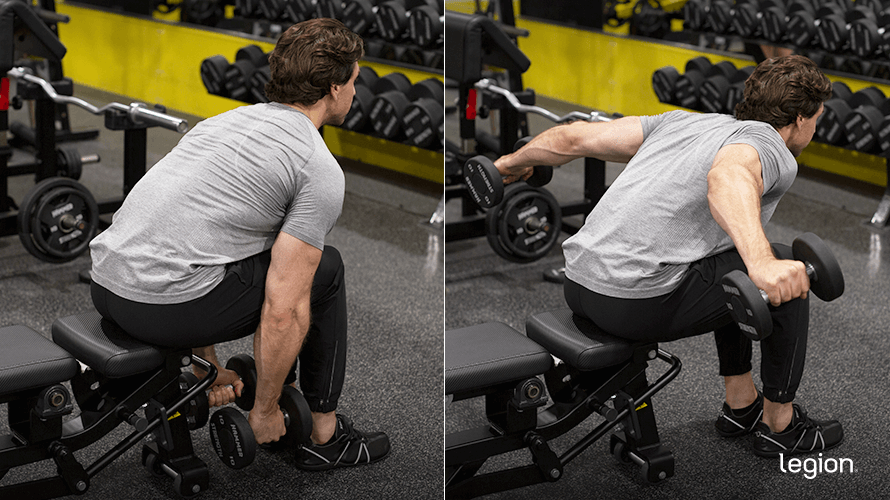
The dumbbell rear lateral raise is an effective dumbbell exercise for training your upper back, including your rear delts, traps, and rhomboids.
How to:
- Whether standing or seated, bend at the hips so that your upper body is as close to parallel to the ground as possible.
- Hold a dumbbell in each hand, and while keeping your back flat, lift the dumbbells out to the side until your upper arm is parallel to the ground. You don’t have to keep your arms perfectly straight—having a slight bend in your elbows is normally more comfortable.
- Reverse the movement and return to the starting position.
10. Alternating Dumbbell Curl

Alternating dumbbell curls train your biceps independently, helping prevent one arm from getting bigger or stronger than the other.
How to:
- Stand upright holding a dumbbell in each hand, with your arms at your sides and your palms forward.
- Bend your right elbow until the dumbbell is in front of your right shoulder.
- Lower the dumbbell to the starting position and repeat with your left arm.
The Best Pull Day Workout Routine for Size and Strength
This workout contains the best pull exercises and the perfect amount of volume and intensity to help you gain muscle and strength:
- Barbell Deadlift: 3 sets of 4-to-6 reps with 2-to-3 min rest
- One-Arm Dumbbell Row: 3 sets of 4-to-6 reps with 2-to-3 min rest
- Pull-up: 3 sets of 6-to-8 reps with 2-to-3 min rest
- Alternating Dumbbell Curl: 3 sets of 6-to-8 reps with 2-to-3 min rest
3 Tips for More Effective Pull Workouts
1. End every set 1-to-3 reps shy of muscle failure.
As I explain in my fitness books for men and women, to maximize your results, you must take most of the sets in your pull workouts to within a rep or two of failure.
Ask yourself at the end of each set, “If I had to, how many more reps could I have gotten with good form?” If the answer is more than two, increase the weight or reps to make your next set more challenging.
2. Once you hit the top of your rep range for a set, move up in weight.
If your pull workout plan calls for 4-to-6 reps of the deadlift and you get 6 reps for a set, add 10 pounds to your next set.
If you manage 3 or fewer reps with the new weight, reduce the weight by 5 pounds to ensure you stay in the 4-to-6 rep range.
Follow this pattern of trying to add reps or weight to every exercise in every workout.
3. Take the right supplements
These supplements can help you optimize your pull day workout performance and gains:
- Protein powder: Protein powder provides your body with the nutrients needed to build muscle tissue and recover from workouts. If you want a clean and delicious protein powder, try Whey+or Casein+.
- Creatine: Creatine boosts muscle and strength gain, improves anaerobic endurance, and reduces muscle damage and soreness from your workouts. For a natural source of creatine that also includes two other ingredients to enhance muscle growth and improve recovery, try Recharge.
- Pre-workout: A high-quality pre-workout enhances energy, mood, and focus, increases strength and endurance, and reduces fatigue. For a top-tier pre-workout containing clinically effective doses of 6 science-backed ingredients, try Pulse with caffeine or without.
(If you’d like even more specific advice about which supplements you should take to reach your health and fitness goals, take the Legion Supplement Finder Quiz, and in less than a minute, you’ll know exactly what supplements are right for you. Click here to check it out.)
+ Scientific References
- Page, P. (2011). SHOULDER MUSCLE IMBALANCE AND SUBACROMIAL IMPINGEMENT SYNDROME IN OVERHEAD ATHLETES. International Journal of Sports Physical Therapy, 6(1), 51. /pmc/articles/PMC3105366/
- Youdas, J. W., Amundson, C. L., Cicero, K. S., Hahn, J. J., Harezlak, D. T., & Hollman, J. H. (2010). Surface electromyographic activation patterns and elbow joint motion during a pull-up, chin-up, or perfect-pullupTM rotational exercise. Journal of Strength and Conditioning Research, 24(12), 3404–3414. https://doi.org/10.1519/JSC.0B013E3181F1598C
- Park, Se-yeon, and Won-gyu Yoo. “Differential Activation of Parts of the Latissimus Dorsi with Various Isometric Shoulder Exercises.” Journal of Electromyography and Kinesiology, vol. 24, no. 2, Apr. 2014, pp. 253–257, https://doi.org/10.1016/j.jelekin.2013.12.004.
- Gerling, Michael E., and Stephen H. M. Brown. “Architectural Analysis and Predicted Functional Capability of the Human Latissimus Dorsi Muscle.” Journal of Anatomy, vol. 223, no. 2, 13 June 2013, pp. 112–122, https://doi.org/10.1111/joa.12074.
- Stokes, T., Hector, A. J., Morton, R. W., McGlory, C., & Phillips, S. M. (2018). Recent Perspectives Regarding the Role of Dietary Protein for the Promotion of Muscle Hypertrophy with Resistance Exercise Training. Nutrients, 10(2). https://doi.org/10.3390/NU10020180
- Jd, Branch. “Effect of Creatine Supplementation on Body Composition and Performance: A Meta-Analysis.” International Journal of Sport Nutrition and Exercise Metabolism, 1 June 2003, pubmed.ncbi.nlm.nih.gov/12945830/.
- Eckerson, Joan M., et al. “Effect of Creatine Phosphate Supplementation on Anaerobic Working Capacity and Body Weight after Two and Six Days of Loading in Men and Women.” The Journal of Strength and Conditioning Research, vol. 19, no. 4, 2005, p. 756, https://doi.org/10.1519/r-16924.1.
- Bassit, Reinaldo Abunasser, et al. “Effect of Short-Term Creatine Supplementation on Markers of Skeletal Muscle Damage after Strenuous Contractile Activity.” European Journal of Applied Physiology, vol. 108, no. 5, 3 Dec. 2009, pp. 945–955, https://doi.org/10.1007/s00421-009-1305-1.








